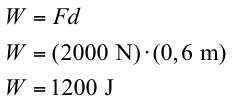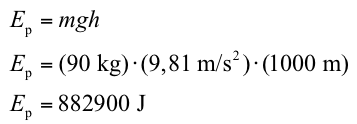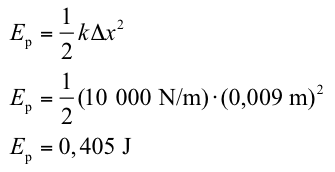28

Work of force F acting on a body can be defined in several ways. The work performed by a constant force acting parallel to the displacement of a body is defined as44:

where W45 is work (J), F is the magnitude of force (N), and d is displacement of the body (m).
Work is product of force and displacement of a body along the same line as that force is acting.
To specify work performed when a force is acting on a body we must know three pieces of information:
Figure 12 Reaction forces46 acting on a person during a bench press exercise and the centre of gravity of the moving mass. Black arrows FA and FB represent reaction forces by which the ground acts on the bench. Solid blue arrow FC represents the resultant reaction force. Blue dot represents the centre of gravity of the barbell – arms system.

For example a body builder during a bench press exercise acts against a barbell and his arms with a constant force of 2000 N. The centre of gravity of the barbell – arms system is vertically displaced by 0,6 m (Fig. 12). What is the work performed by body builder?

Mechanical work can also have a negative value. It is so when a body is displaced against the direction of the acting force. Ice hockey goal keeper performs negative work when catching a puck into his catching glove, gymnast when he does crucifix on rings, weight lifter when he drops the barbell from the top to the bottom position, the pad does it when gymnast lands on it, friction force of skis is also negative. Breaking forces generally perform negative work.
Positive work is performed when the body is displaced along the same line as the force is acting. Javelin thrower performs positive work when moving javelin in the direction of the throw, weight lifter does it when lifting the barbell, the surface of ski jump does it in the moment of the ski jumper’s take-off.
Muscles can also perform mechanical work. When muscles contract, they produce tractive forces that act on muscles’ insertions. Muscle contractions are divided into:
Concentric contraction – „the force generated is sufficient to overcome the resistance, and the muscle shortens as it contracts“ (Knuttgen a Kraemer, 1987). Muscles then perform positive mechanical work because muscle force acts along the line of muscles’ insertions. The muscle shortens.
Eccentric contraction – „the force generated is insufficient to overcome the external load on the muscle and the muscle fibres lengthen as they contract“ (Knuttgen a Kraemer, 1987). Muscles then perform negative mechanical work because muscle force acts against the direction of the motion of muscles’ insertions. The muscle lengthens.
Isometric contraction – „the muscle remains the same length“ (Knuttgen a Kraemer, 1987). There is no displacement of muscles’ insertions in relation to each other, therefore no work is performed.
In mechanics energy is defined as an ability of a body to perform work. We know many forms of energy: acoustic energy, light energy, chemical energy, nuclear energy, etc. In biomechanics we are most of all interested in mechanical energy, which can have two forms: kinetic energy and potential energy. Energy is denoted by the letter E and the SI unit of energy is joule (J)
There are two forms of mechanical energy: kinetic energy, related to motion of a body, and potential energy, related to the position of a body in the Earth’s gravitational field.
A body in motion has ability to perform work through its motion. Kinetic energy is directly proportional to the square of the body’s velocity. Kinetic energy is defined as:

where Ek is kinetic energy (J), m is mass (kg), and v is velocity (m/s).
As we can see in the above definition, to express the magnitude of kinetic energy we have to know the mass and the velocity of the given body (or a human body).
What is the kinetic energy of a tennis ball with the mass of 60 g (0,06 kg) and the velocity of 108 km/h (30 m/s)?

Specification of kinetic energy is much simpler than that of mechanical work because to measure the mass and the velocity of a body is easier than to measure forces acting on a body.
Potential energy is ability of a body to perform work due to its position. Let us mention two types of potential energy: gravitational potential energy and elastic potential energy47.
Gravitational potential energy is ability of a body to perform work due to its position in the Earth’s gravitational field. Mathematically the potential energy can be expressed as:

where Ep is potential energy (J), m is mass (kg), g is gravitational acceleration (9,81 m/s2) and h is height (m).
What is the potential energy of a skier with the mass of 90 kg at the start of a downhill run when the altitude difference between the start and the finish is 1000 m?

Elastic energy is an ability of a body to perform work due to its being deformed. When, for example, the pole of a pole vaulter is bent, elastic energy is stored in the glass fibre of the vault. The more deformed the pole is, the larger elastic energy is stored in the glass fibre. The amount of elastic energy also depends on rigidity, which is determined by the material qualities of the body.

where Ep is elastic energy (J), k is rigidity (N/m) and Δx is change to the length of the body (m).
Elastic energy depends on the measure of deformation and rigidity of the body.
What elastic energy is stored in a tendon of an athlete which stretches by 0,009 m, if the rigidity of tendon is 10 000 N/m?

The total energy of an athlete is a sum of kinetic, potential, and elastic energy.
44 Work can also be defined as product of the magnitude of projection of force, acting on a body, into the direction of that body’s motion, and the distance covered by that body.Zpět
45 W – from the English workZpět
46 Reaction forces acting on legs are neglected here. The technique of bench press in this case requires unladen legs.Zpět
47 To make things simple, in the following text we will name these two types of energy as potential energy and elastic energy.Zpět